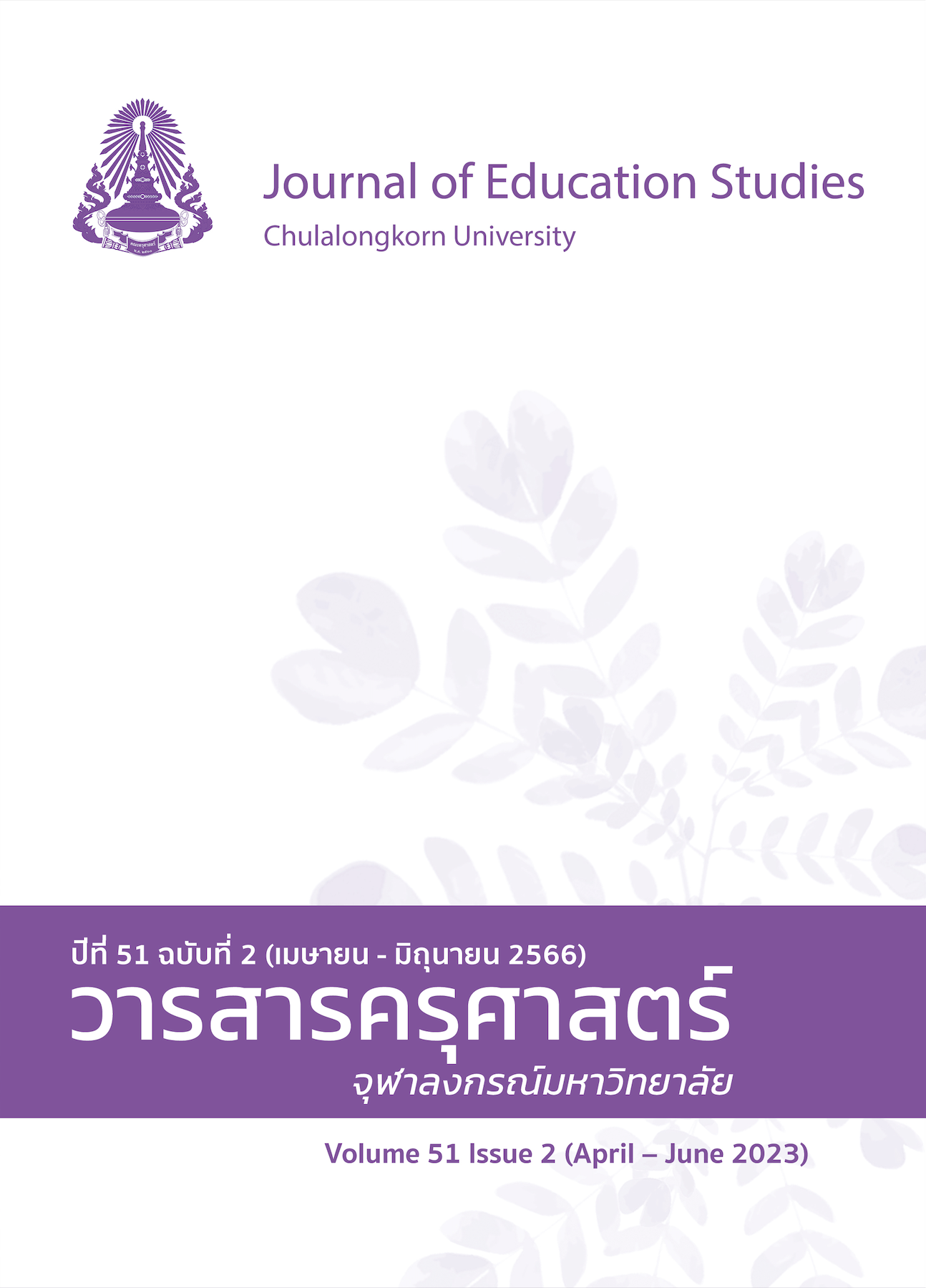Needs Assessment of Teachers’ Instructional Video Production Ability
DOI:
https://doi.org/10.14456/educu.2023.12Keywords:
needs assessment, video production ability, teacherAbstract
The purposes of this study were to explore whether teachers in Phayao needed to enhance their ability to produce instructional videos and to identify the problems and obstacles this group of teachers faced in producing instructional videos. The samples in this study consisted of 359 teachers working in educational institutions under the supervision of different agencies in Phayao. The data were collected using a survey on the need for promoting teachers’ instructional video production abilities, and a modified Priority Needs Index (PNImodified) was employed to analyze the collected data. In addition, the problems and obstacles the teachers faced in producing instructional videos were determined using content analysis of the answers to the open-ended survey questions.
The results of the needs analysis showed that the most urgent need in teacher development concerning instructional video production was video delivery, followed by the ability to develop and design instructional videos. In terms of the problems and obstacles most frequently encountered in producing instructional videos, the teachers in Phayao lacked the basic knowledge of video production and the ability to shoot and design instructional videos, respectively.
References
ภาษาไทย
คัชรินทร์ มหาวงศ์ และปาลิตา สุขสำราญ, (2564). โครงการพัฒนาเครือข่ายครูนักวิจัยในการสร้างนวัตกรรมการเรียนรู้เพื่อ
ยกระดับผลสัมฤทธิ์ทางการเรียนสำหรับสถานศึกษาในจังหวัดพะเยา (รายงานการวิจัย). สำนักงานคณะกรรมการ ส่งเสริมวิทยาศาสตร์ วิจัยและนวัตกรรม (สกสว.) สำนักงานปลัดกระทรวงศึกษาธิการ
นรินธน์ นนทมาลย์. (2561ก). รูปแบบการผลิตวิดีโอออนดีมานด์เพื่อการเรียนรู้ในการเรียนทางไกลแบบเปิด. วารสารสารเทคโนโลยีและสื่อสารการศึกษา. 13(14-15).
นรินธน์ นนทมาลย์. (2561ข). วิดีโอปฏิสัมพันธ์ในการเรียนแบบเปิดในศตวรรษที่ 21. วารสารครุศาสตร์, 46(4). https://so02.tci-thaijo.org/index.php/EDUCU/article/view/163454/118204
รัชดากร พลภักดี. (2563). การใช้สื่อสังคมออนไลน์ในการจัดการเรียนการสอนในสถานการณ์ COVID-19. วารสารครุศาสตร์อุตสาหกรรม, 19(1), 1-5. https://so06.tcithaijo.org/index.php/jomld/article/view/250567
มูลนิธิการศึกษาทางไกลผ่านดาวเทียมในพระบรมราชูปถัมภ์. (2562). พัฒนารูปแบบการออกอากาศ. Retrieved from https://www.dltv.ac.th/about-us
สำนักงานคณะกรรมการการศึกษาขั้นพื้นฐาน. (2562, 30 มิถุนายน). คู่มือการประเมินรางวัลทรงคุณค่า สพฐ.OBEC AWARDS เล่มที่ 3. https://www.obec.go.th/wp-content/uploads/2019/06/คู่มือการประเมิน-รางวัลทรงคุณค่า-สพฐ.-OBEC-AWARDS-เล่มที่-3.pdf
สำนักงานคณะกรรมการข้าราชการครูและบุคลากรทางการศึกษา. (2565, 1 กรกฏาคม). รูปแบบการจัดทำไฟล์วีดิทัศน์ตามหลักเกณฑ์และวิธีการประเมินตำแหน่งและวิทยฐานะข้าราชการครูและบุคลากรทางการศึกษา ตำแหน่งครู ตำแหน่งผู้บริหารสถานศึกษาและตำแหน่งศึกษานิเทศก์ https://otepc.go.th/images/00_YEAR2565/03_PV1/V15-2565_QRCode.pdf
สำนักงานปลัดกระทรวงศึกษาธิการ. (2565, 18 กุมภพันธ์). ศธจ.พะเยา ดำเนินการอบรมเชิงปฏิบัติการสร้างความรู้ความเข้าใจเกี่ยวกับการสร้างนวัตกรรมด้านการเรียนรู้ภายใต้โครงการ Innovation For Thai Education (IFTE) ประจำปีงบประมาณ พ.ศ.2565. http://phayaopeo.com/news.php?n=734
สำนักงานเลขาธิการสภาการศึกษา. (2564, 28 มิถุนายน ). ขอเชิญชวนส่งผลงานเข้าประกวดสื่อนวัตกรรมการจัดการเรียนรู้ สื่อสร้างสรรค์ปั้นอนาคตคนไทย ๔.๐ http://www.onec.go.th/th.php/page/view/Information/4498
ภาษาอังกฤษ
Advance Media New York. (2021, July 6). 4 Essential Components to Consider When Producing Video. from https://www.advancemediany.com/essential-components-to-consider-when-producing-video/
Boclips. (2021, April 7). How to Use Video in Synchronous and Asynchronous Learning Design. From https://www.boclips.com/blog/how-to-use-video-in-synchronous-and-asynchronous-learning-design
Brady, A. K., & Pradhan, D. (2020). Learning without borders: asynchronous and distance learning in the age of COVID-19 and beyond. ATS scholar, 1(3), 233-242.
Castillo, S., Calvitti, K., Shoup, J., Rice, M., Lubbock, H., & Oliver, K. H. (2021). Production Processes for Creating Educational Videos. CBE—Life Sciences Education, 20(2), es7.
Chen, C., Wong, V., Teh, C., & Chuah, K. (2017). MOOC videos-derived emotions. Journal of Telecom munication, Electronic and Computer Engineering (JTEC), 9(2-9), 137-140.
Cohen, J. (2013). Statistical power analysis for the behavioral sciences. Routledge.
Desktop Documentaries. (2022). Filmmaking 101 What Is Video Production? https://www.desktop-documentaries.com/what-is-video-production.html
Fakhruddin, Z. (2020). Designing English Listening Materials through YouTube Video Editing: Training for English Teachers of Islamic Junior High Schools, Parepare, South Sulawesi. Indonesian Journal of English Language Teaching and Applied Linguistics, 4(2), 275-290.
Genard, G. (2017, December 3). Video Conferencing: How to Speak Dynamically In Front of the Camera. https://www.genardmethod.com/blog/video-conferencing-how-to-speak-dynamically-in-front-of-the-camera
Jenkins, P. (2022, April 11). What Are the 3 Stages of a Video Production. https://brilliantio.com/what-are-the-3-stages-of-a-video-production/
Jenkinson, J. (2017). The role of craft-based knowledge in the design of dynamic visualizations. In Learning from Dynamic Visualization (pp. 93-117). Springer.
Karunanayake, P. (2020). HOW TO SPEAK EFFECTIVELY IN FRONT OF A CAMERA. https://www.linkedin.com/ pulse/how-speak-effectively-front-camera-prabath-karunanayake
Kolber, S. (2022, April 29). Teaching techniques – six ways to use Instructional Video. https://www.teacher magazine.com/au_en/articles/teaching-techniques-six-ways-to-use-instructional-video
Landis-Eigsti, J. (2021, January 12). Why Choosing the Right Thumbnail on YouTube Is So Important. https://jacob-le.com/why-choosing-the-right-thumbnail-on-youtube-is-so-important/
Martin, F., & Betrus, A. K. (2019). Instructional Video. In Digital Media for Learning (pp. 67-84). Switzerland: Springer.
Mayer, R. E., Fiorella , L., & Andrew, S. (2020). Five ways to increase the effectiveness of instructional video. Educational Technology Research and Development, 68(3), 837-852.
McGill, G. G. (2017). Designing instructional science visualizations in the trenches: Where research meets production reality. In Learning from Dynamic Visualization (pp. 119-150). Springer.
Mittal, E. (2018, May 25). 6 Reasons Why YouTube Thumbnails are Important for Traffic. https://medium. com/the-video-marketers-playbook/6-reasons-why-youtube-thumbnails-are-important-for-traffic-4cb5dab94e1
Nicki. (2022, August 8). Learning video design principles. https://www.adelaide.edu.au/learning-enhance ment -innovation/news/list/2022/08/08/learning-video-design-principles
Noetel, M., Griffith, S., Delaney, O., Sanders, T., Parker, P., del Pozo Cruz, B., & Lonsdale, C. (2021). Video improves learning in higher education: A systematic review. Review of educational research, 91(2), 204-236.
Nonthamand, N. (2020). Guideline to Develop an Instructional Design Model Using Video Conference in Open Learning. International Journal of Emerging Technologies in Learning (iJET), 15(03), 140-155.
Panopto. (2022, July 15). Synchronous vs. Asynchronous Communication: What’s The Difference? https://www.panopto.com/blog/learning-and-development-asynchronous-vs-synchronous-video-communications-whats-the-difference/
Red Hall Films. (2022). Aspects of Video Production to Keep in Mind. https://redhallfilms.com/aspects-video-production-keep-mind/
Riordan, T. O. (2012). Video Production Workflow. Retrieved from http://www.jisc.ac.uk/~/ media/ 195B9F6D012346328DD8EEC7239781BD.ashx
Sablić, M., Mirosavljević, A., & Škugor, A. (2020). Video-Based Learning (VBL)—Past, Present and Future: an Overview of the Research Published from 2008 to 2019. Technology, Knowledge and Learning, 1-17.
Sergeant, A., & MacDonald, P. A. (2017). Video Production to Enhance Multimedia Presentations Skills: An Undergraduate Business Project. Business Education Innovation Journal, 9(1). 25-34.
Solak, M. S., Hava, K., & Mese, C. (2019). Variables Predicting Video Development Process in Teacher Training. Malaysian Online Journal of Educational Technology, 7(2), 97-112.
Stanley, D., & Zhang, Y. (2018). Student-Produced Videos Can Enhance Engagement and Learning in the Online Environment. Online Learning, 22(2), 5-26.
Tarozaite, L. (2016, March 24). Speaking in front of camera – is it the same as public speaking? Tips on how to improve your on-camera presence. https://www.linkedin.com/pulse/speaking-front-camera-same-public-tips-how-improve-your-tarozaite
Watt, D. (2019). Video production in elementary teacher education as a critical digital literacy practice. Media and Communication 7(2), 82-99.
Zeng, X., & Wang, T. (2021). College Student Satisfaction with Online Learning during COVID-19: A review and implications. International Journal of Multidisciplinary Perspectives in Higher Education, 6(1), 182-195.
Downloads
Published
How to Cite
Issue
Section
License

This work is licensed under a Creative Commons Attribution-NonCommercial-NoDerivatives 4.0 International License.




